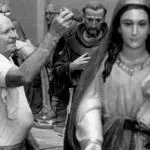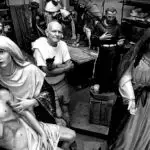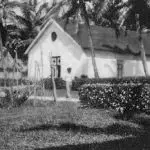Father Marcian Pellet
Artist priest
Father Marcian Pellet (1909 – 1996), OFM Cap. was a Capuchin missionary, artist, sculptor, and amateur archaeologist. He spent 57 years dedicated to the Catholic Church in the Mariana Islands, almost four of those years in a civilian Prisoner of War camp in Japan during World War II. His artistic works grace several locations in Guam.
Pellet was born on 10 November 1909, in Murphysboro, Illinois. He entered the Capuchin Order in 1931 and was ordained a priest in 1939. That same year he volunteered for the overseas missions and was sent to Guam, arriving in December 1939. He served in Malesso’ and Humåtak in 1940.
When Guam was taken over by the Japanese in December 1941, Fr. Pellet was sent along with the other American Capuchin missionaries to Prisoner of War camps in Japan on 10 January 1942. The friars spent three and a half years in several camps in and around Kobe, Japan. In August 1945, they were freed by American forces.
The following year, after recuperating in the US mainland, Pellet returned to Malesso’ and Humåtak in Guam. But the American Capuchins after the war were now responsible for the Northern Mariana Islands, and CHamoru-speaking missionaries were needed there. Pellet was assigned to Rota in 1947. He made the decision to move the people back to the village of Songsong, from which they were evicted by the Japanese because of war preparations. Pellet was for a time the only Westerner on Rota and thus was the civil liaison between the military government and the island residents.
In 1949, CHamorus from Yap were to be repatriated to the Marianas and Tinian was chosen for their re-settlement. Pellet became the first resident Catholic priest of Tinian since the 19th century. He built San Jose Church in Tinian in 1956. He also attended to the patients at the leprosarium which cared for people from all over Micronesia.
Leaving Tinian in 1958, Pellet worked in various ministries over the next dozen years. He served in Rota again two separate times; he assisted in Saipan, taught at Father Duenas Memorial School on Guam and was pastor of the Catholic church in the village Ordot on Guam. In 1973, due to deteriorating eye sight, Pellet retired from full-time ministry and took up residence at Saint Fidelis Friary.
Pellet was an avid, albeit unschooled, artist. Even in prison camp, he painted watercolors. These survived the war and were put on display many years later on Guam. He painted religious art for various churches throughout the Marianas, many of which are now lost. Still, his artwork can be seen today in churches throughout Guam, including the Dulce Nombre de Maria Cathedral-Basilica in Hagåtña, Saint Francis Church in Yona, and Saint Fidelis Friary in Agana Heights.
Besides religious art, Pellet was called upon to repair secular statuary. In 1983, a civic group asked him to repair the vandalized statue of Sirena, a mermaid of CHamoru legend, which sits at the San Antonio Bridge, or Tollai Acho (Stone Bridge), in Hagåtna. In 1989, he took on his last project, the repair of the John F. Kennedy statue which stands in front of the Tamuning public high school named after the US president.
When he was in Tinian, Pellet did some amateur archaeological digging around the House of Taga, which is the largest set of remaining latte (monolith stone pillars with capstones) in the Marianas, and contributed to archeologist Alexander Spoehr’s article which appeared in the Journal of the Polynesian Society in 1961. Artifacts from Pellet’s digs were sent to the Bishop Museum in Hawai’i. Pellet also discovered ancient CHamoru petroglyphs in Tinian at a cave now called “Marcian Cave.”
Pellet died on 18 November 1996.
For further reading
Forbes, Eric, OFM Cap. The Many Colors of Father Marcian. Agana Heights: Capuchin Friars, Vice Province of Star of the Sea, 2006.
Spoehr, Alexander. “Conquest Culture and Colonial Culture in the Marianas During the Spanish Period.” In The Changing Pacific: Essays in Honour of H.E. Maude. Edited by Niel Gunson. New York: Oxford University Press, 1978.



